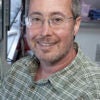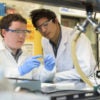For graduate student Amy Braun, an experiment that revealed sex differences in a model of autism wasn’t initially a surprise – differences between male and female mice had been found in many other studies, and had been largely ignored.
A few years later, however, Braun challenged the assumptions that led her colleagues to disregard such findings, and that’s when things got interesting. She found there was something to learn about autism from studying what others had taken for granted. And, she said, the experience changed the kinds of questions she’s interested in asking. “It’s completely changed the way I look at everybody’s work, including my own,” she said.
While not every reexamined assumption will have such life-changing results or even lead to new insights, Braun is not alone in discovering something useful from questioning her field’s assumptions.
A second look at cells that make up 90 percent of the brain revealed new insights into neurological disease. A collaboration between epidemiologists and anthropologists helped doctors understand the spread of bird flu in China. And social scientists learned that contrarians, though annoying, can help strengthen team decisions. Across disciplines – and often by working across traditional academic boundaries – Stanford researchers have made big discoveries by taking a fresh perspective.

The brain’s silent majority
Neuroscientists thought glia were just the scaffolding that holds the brain together. A second look revealed how our most complex organ keeps itself running. Read more.

Do you have a contrarian on your team?
Nobody really likes the devil’s advocate, but having one on the team can help groups make better decisions. Read more.

Reading between the genes
Biologists long thought non-coding or “junk” DNA did literally nothing. Challenging that view opened a new window into how our genes – and our bodies – interact with the outside world. Read more.

Of mice, men and women
For generations, researchers studied males and assumed their results applied to females. They were wrong, and now Stanford researchers are trying to figure out when and why sex – and gender – make a difference. Read more.

Nearly all microbes inside us are unknown to science
It was relatively recently that scientists figured out we actually need much of the bacteria that live inside us – and it was only last year that they realized how little we know about the organisms that call us home. Read more.

The future of energy storage
Managing wind, solar and other renewable energy sources poses challenges our infrastructure isn’t designed to handle. Now, Stanford scientists are designing new batteries and power grids to deal with the problem. Read more.

The serious side of the Donald Trump phenomenon
Three years ago Donald Trump looked like a sideshow, but his popularity reflected resentments that experts had largely ignored, political scientists argued in 2015. Read more.

Climate mitigation could yield trillions in economic benefits
Fixing a global problem like climate change seems like it would cost big bucks, but when Stanford scientists ran the numbers, they found reducing greenhouse gases could save trillions. Read more.

Screening people for diseases doesn’t necessarily save lives
If you want to save lives, the obvious thing to do is to screen people for disease – but that might not do much good, a Stanford researcher found. Read more.

Sociologists urge use of big data to study human interaction
Social scientists often rely on laboratory experiments to understand human behavior. Now, there’s an alternative: field experiments conducted online. Read more.

Well-meaning statements can spread stereotypes
It’s reasonable to think that saying, for example, girls are as good as boys at math could combat stereotypes about academic abilities. In fact, it could do the opposite. Read more.

Massive cyberattack poses policy dilemma
The Internet of Things – everything from web-connected TVs to smart refrigerators – seemed like a great idea. It turned out to be an ideal platform for a devastating cyberattack. Read more.

Pathways: From the eye to the brain
Over two decades, neurobiologists challenged the assumption that the brain’s vision circuits are fixed by our genes. In the process, they discovered the body’s immune system is involved in remodeling them. Read more.

Druglike molecules produced by gut bacteria can affect gut, immune health
Drug companies have for years relied on so-called small molecules to generate ideas for new drugs. It turns out the bacteria in our guts have been doing pretty much the same thing. Read more.

Using social networks to track bird flu
When epidemiologists wanted to understand a 2013 outbreak of bird flu in China, they didn’t just look for answers in the medical community – they also turned to a biological anthropologist who studies demographics and social networks. Read more.

Stanford researchers find that swarms of tiny organisms mix nutrients in ocean waters
On its own, a tiny crustaceans called a krill couldn’t possibly have much impact on the global climate – but put enough of them together and everything changes, civil and environmental engineers found. Read more.

Cell tower: The rise of the cilium
The antenna-like shape of the primary cilium bothered biologists for nearly a century. Then, they realized it actually was a kind of antenna and linked it to polycystic kidney disease and Bardet-Biedl syndrome. Read more.

New Stanford engineering tools record electrical activity of cells
To start to understand the brain, neuroscientists needed to track thousands of brain cells at once. Making that happen took an unprecedented – and often befuddling – collaboration between electrical engineers and brain scientists. Read more.
Braun was a graduate student in the lab of Theo Palmer, a professor of neurosurgery, and is now a postdoctoral fellow in the lab of Virginia Winn, an associate professor of obstetrics and gynecology.